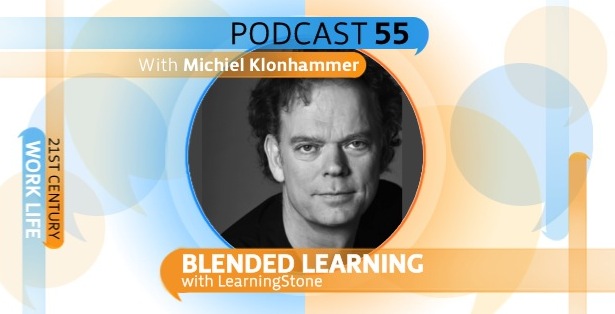or how to create a great collaborative learning experience
As a professional trainer you might know how to make participants feel comfortable and motivated so they will work, collaborate and learn together. But how do you make people feel comfortable and motivated when you are using an online environment.
There are two core assumptions that underlie approaches to building blended learning communities: (1) that the deeper the personal relationships between learners, the richer the collaborative learning experience; and (2) that relationships between learners may be strengthened through structuring group interactions (using technology) before and/or after a face-to-face training event. (Strategies for Collaborative learning, Soren Kaplan*)
Our experience shows that it is possible to stimulate social activities, cooperation and collaborative learning among participants in an e-learning setting. Based on our experience with users of LearningStone we came up with a few suggestions.
1. Mix online and offline
If you believe in blended learning like us, you’ll find this obvious. The best way to stimulate online collaboration is warming things up with an offline session. It’s even worth having just one single offline (fun!) session so that everyone gets to know each other.
If that’s not possible because everyone is too busy or too far away, use a webinar tool and consider recording it for people who have missed it. You can also plan an online chat in the first or second week.
2. Explain how things work
Let the participants get familiar with the learning platform. Offer them some time to get to know the learning platform. Invite them into your online group at least a week before the course starts They have to feel comfortable with the learning environment. Let them play around a little and use a video to explain how it all works. Don’t worry about the quality of video: a tablet or modern phone is good enough.
3. Ask everyone to be personal and reward it!
A virtual learning environment works best if people dare show themselves. When the participants feel comfortable with navigating the learning environment it’s time to present themselves. An invitation from teachers or even a first assignment to build up their personal profile always turns out to be very effective.
Ask them to use a good picture of their face (no funny stuff, cartoons etc) that will appear in all communication. Let them add another picture to their profile of a situation at work, at home or doing something they love (thrill-seeking sports always work well :-). Ask them to add some background info to their profile, what they expect from the course and something personal. Invite everyone to read the other profiles.
If a profile makes someone walk over to the owner at a live session and say “Hey aren’t you the person who goes snowboarding in the alps?” you have succeeded!
And don’t forget, as a trainer you have to give the right example first! Participants will follow your example and don’t forget to give them a huge public compliment for something like a great picture.
4. Tell participants that they should work and learn together
If you want your participants to work and learn together, tell them how that works. Tell everyone what you expect from the very beginning of the course. Don’t just throw the environment at them and walk away.
It’s fine if there is some off topic chatter but try to give that a place (a thread in a discussion or just some time in the beginning of the course) so that relevant collaboration doesn’t get hidden. If you’re working for a client, get him or her involved from the start and make sure they understand the need to communicate.
5. Make a schedule that creates opportunities to collaborate
When arranging courses for participants from different working environments and even from different countries, realise they may have holidays, exams and heavy workloads at different times which makes it hard to follow a strict time schedule. Structure the weekly programmes a bit and give assignments over a longer period than one week to enable students to find time for collaboration. It helps to send automatic notifications about events and assignments each week, so every participant can fit these in his or her own week schedule.
6. Don’t let them be passive!
Everyone knows how crowds sometimes do very little if something needs to be done. Everyone assumes the next person can do it better, is more daring, smarter etc. Psychologists call this diffusion of responsibility and it can easily occur in online discussions or other collaborative moments. To avoid this, ask specific people to start a discussion, upload some content or ask for reactions, and do it yourself as well!
7. Use deadlines and reminders
It’s the downside of being a trainer: you simply need to be like a school teacher sometimes! If you ask people to react to some content or work, it’s important to tell them to do it before a certain date and yes, you’ll have to remind them. More than once.
It’s okay to do that reminding automatically with scheduled messaging as long as you’re not bombarding people with messages and as long as the messages still feel personal.
8. Allow playfulness
The great thing about live or offline training sessions, is that it’s easy to have a sense of humor and to allow playfulness. You simply allow for some chaos here and there and breaks are great for some banter. This is much harder online as you miss nonverbal communication and as you don’t want permanent content to be messed up by silly remarks anyway. Our trick is to use group chat or specific discussions or wall threads to do this. If, for example, you’re running an international group, why not ask everyone to post a joke from their country… yes, just for fun. Fun groups just work better.
9. Create Memorable moments
A teacher once told us: the key to working with groups is creating memorable moments. Do something original when you’re running an online group. Use a funny video, post pictures of yourself, celebrate a birthday… whatever it takes to make your participants remember the moment. This deepens relationships and stimulates learning.
And it will make your participants remember you and your company the next time they need a trainer.
Any comments? Let us know!
Sjoerd Boersma and Michiel Klønhammer
sjoerd at learningstone.com and michiel at learningstone.com
Founders of LearningStone
Twitter: www.twitter.com/learningstoneHQ .










